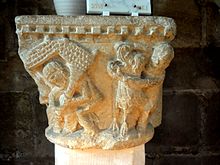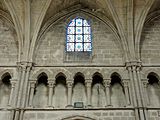Notre-Dame-de-l'Assomption (Auvers-sur-Oise)
The Catholic parish church of Notre-Dame-de-l'Assomption in Auvers-sur-Oise , a parish in the Val-d'Oise department in the French region of Île-de-France , was begun in the 12th century in the Romanesque style and in the 13th century continued in Gothic style . The church became famous for the painting The Church of Auvers by Vincent van Gogh , which is now in the Musée d'Orsay in Paris . In 1915, the church dedicated to the Assumption of Mary was added to the list of architectural monuments in France as Monument historique .
history
Notre-Dame-de-l'Assomption is mentioned for the first time in 1131 in a document in which the donation of the church to the Abbey of Saint-Vincent in Senlis by the French King Louis VI. is recorded. The oldest surviving part of the church is the apse chapel of the north arm of the transept, which was built in the early 12th century. The choir and transept date from the middle of the 12th century, the nave was built around 1220. Around 1260 the choir head was changed and the windows of the main apse were enlarged and fitted with tracery . In the middle of the 16th century, a square Lady Chapel was added to the south transept.
architecture
Exterior construction
The square bell tower from the late 12th century, covered with a gable roof, rises above the crossing , the upper floor of which is pierced on all four sides by high, pointed arches of sound .
The south portal was created in the 13th century and heavily restored at the end of the 19th century. The tympanum depicts the Assumption of Mary into heaven. Mary holds - as a sign of wisdom and power - a book in her left hand, a scepter in her right hand and is surrounded by a mandorla , which is carried by three angels on each side. During the 16th and 17th centuries, a 14th century Madonna and Child stood on the Trumea pillar , which was badly damaged during the Revolution . The sculpture has been housed there since the Marienkapelle was built.
The west facade is structured by strong buttresses and broken through by a large rose window; the tracery dates from 1876.
inner space
The nave has three aisles and is divided into four bays . The one-bay choir ends with a polygonal closure.
The central nave arcades rest on pillars decorated with leaf capitals . The capitals in the choir and in the crossing have palm leaf and acanthus ornaments, some depict mythical creatures. One capital is provided with scenes from the story of Samson .
The wall elevation is three-storey, a triforium runs above the arcade zone , and pointed arched upper clad windows open above it. The main and side aisles are covered with ribbed vaults, only the Romanesque apse chapel of the north transept still has the original groin vault .
literature
- Jean-Marie Pérouse de Montclos (ed.): Le Guide du Patrimoine. Île-de-France . Hachette, 2nd edition, Paris 1994, ISBN 2-01-016811-9 , pp. 115-117.
- Georges Poisson (ed.): Dictionnaire des Monuments d'Île de France . Éditions Hervas, Paris 2001, ISBN 2-84334-002-0 , pp. 91-92.
- Le Patrimoine des Communes du Val-d'Oise . Flohic Éditions, Volume 2, Paris 1999, ISBN 2-84234-056-6 , pp. 861-864.
Web links
- Église Notre-Dame-de-l'Assomption in the Base Mérimée of the French Ministry of Culture (French)
Coordinates: 49 ° 4 ′ 19 ″ N , 2 ° 10 ′ 34 ″ E








